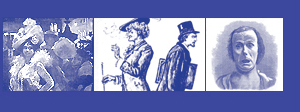Biographies
Alphonse Bertillon (1883- 1914)
Alphonse Bertillon, the French criminal anthropologist and so-called ‘father of scientific detection’, was born in Paris, in 1853 (m. 1883, d. 1914). His father was an influential anthropologist, and amateur statistician. Bertillon taught French in England for a year in 1874, first at the Collegiate School, Smethwick, and then at a school in Bishop’s Stortford. In 1875 he returned to France to complete his military service. His father then arranged for him to take a position as a clerk in the Paris Police Department. He worked as a clerk for several years, sorting and resorting criminal records. He soon became convinced that the old system of identification was hopelessly inadequate, and began to develop a new system based on:
- minute anthropometric measurements - particularly of length and width of head, shape and size of ears, and length of fingers;
- standardised photography - full-face and profile, and the sectional photography of ears; and
- a detailed description of tattoos, size, hair type and colour, and other bodily features.
All this information was recorded on a card, and made up what Bertillon dubbed the p ortrait parlé (spoken portrait). His system of identification, called the Bertillon system, or bertillonage , was introduced in Paris in 1882, and spread quickly through Europe and into America, although it was treated with scepticism in England where Francis Galton’ s method of fingerprint identification was preferred .
In 1888 Bertillon established the Department of Judicial Identity, and he became its first chief. Important criminologists such as Galton, Raffaele Garofalo (1852-1934), Alfredo Niceforo, Ottolenghi, and Enrico Ferri (185-1929) visited him during the 1890s. All were impressed by the precision of his measurements, and used his techniques in their own work. Bertillon w as a police handwriting expert in the Dreyfus trial in 1894. He mistakenly attributed a crucial document to Dreyfus (in fact, it had been forged to implicate him) and so helped to bring about Dreyfus’s wrongful conviction. Bertillon’s complicated, time-consuming, and costly system of measurements, which relied on a prisoner staying completely still, was eventually superseded by the more practical technique of fingerprint analysis. Bertillon was also a pioneer in this technique, making the first fingerprint identification (in 1902) in the absence of an identified suspect.
His major works include: Les Races sauvages (1882); Identification anthropométrique; instructions signalétiques (1885; trans. Signaletic instructions including the theory and practice of anthropometrical identification, 1896).
www.mugu.com/browse/galton/search/essays/pages/galton-1896-bertillon-review_1.htm
www.historybroker.com/items/bert1.htm
www.correctionhistory.org/html/chronicl/dcjs/html/nyidbur1.html

